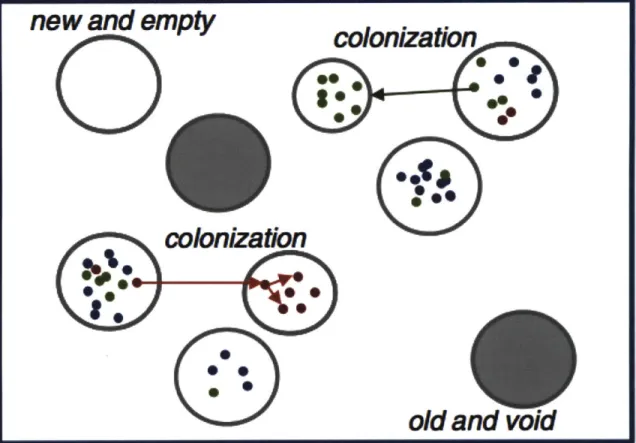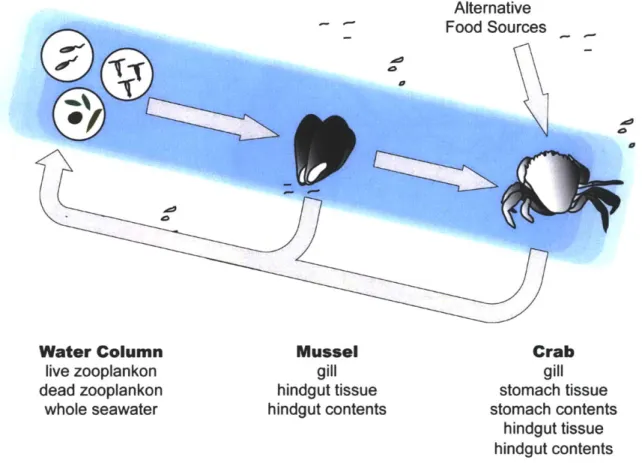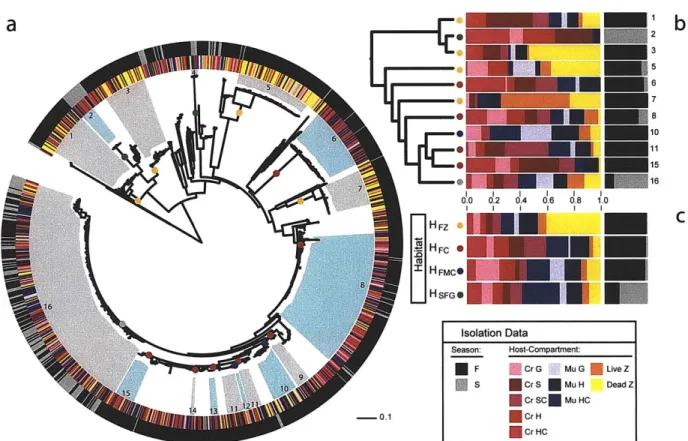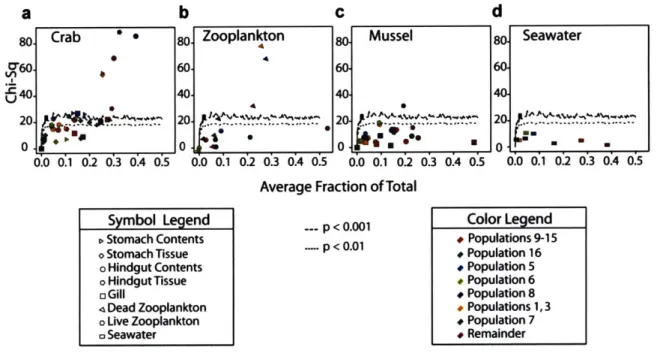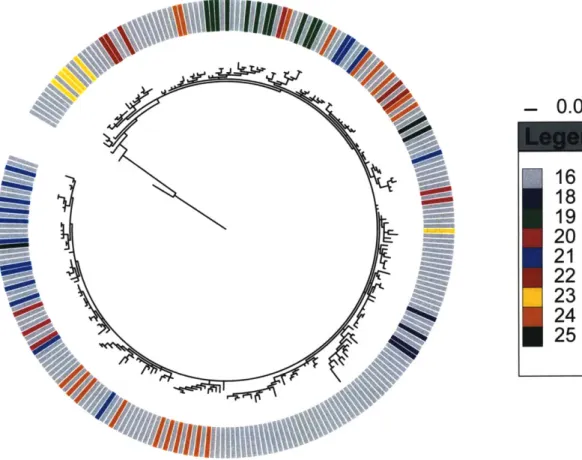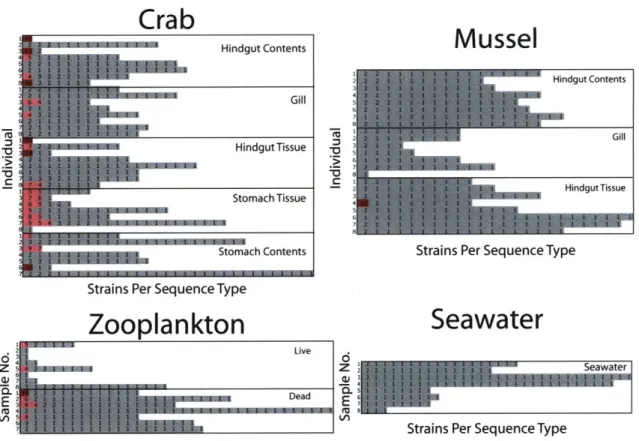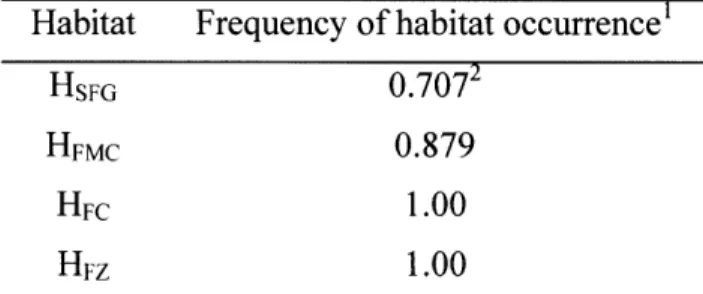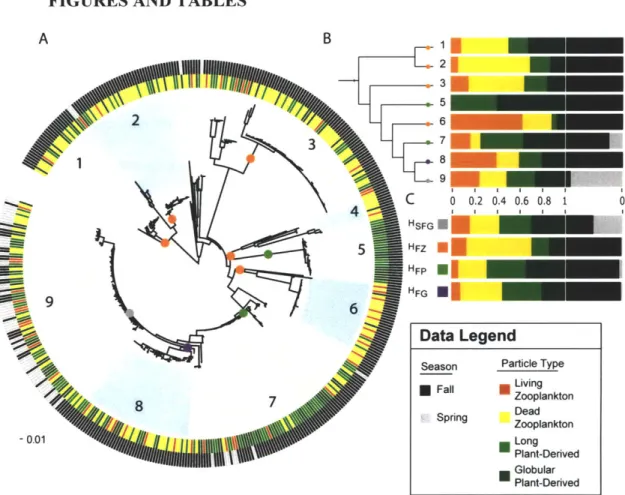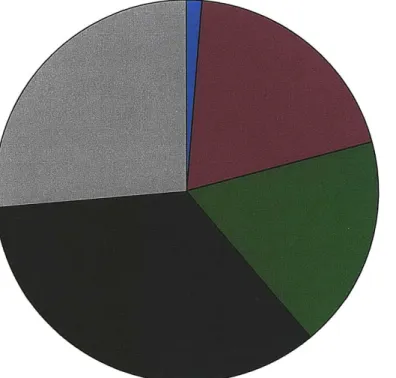ECOLOGY AND POPULATION STRUCTURE OF VIBRIONACEAE IN THE COASTAL OCEAN
By
Sarah Pacocha Preheim
B.S., Carnegie Mellon University, 1997
Submitted to the Department of Civil and Environmental Engineering, Massachusetts Institute of Technology and the Woods Hole Oceanographic Institution in Partial Fulfillment of the
Requirements for the Degree of
ARCHIVES
Doctor of Philosophy in the Field of Biological Oceanography MASSACHUSETTS INSTfTE OF TECHNOLOGY
at the
MASSACHUSETTS INSTITUTE OF TECHNOLOGY
MAR
2
3
2010
and theWOODS HOLE OCEANOGRAPHIC INSTITUTION
LIBRARIES
February 2010
© 2010 Massachusetts Institute of Technology and Woods Hole Oceanographic Institution All rights reserved
Signature of Author
' Joitfr'ogram in Oceanography Departm t of Civil and Environmental Engineering Massachusetts Institute of Technology and Woods Hole Oceanographic Institution
January 12 th2010
Certified by
Martin F. Polz Professor of Civil and Environmental Engineering Massachusetts Institute of Technology Thesis Supervisor Accepted by
Simon Thorrold Chair, Joint Committee for Biological Oceanography Woods Hole Oceanographic Institution Accepted by
Daniele Veneziano Chairman, Departmental Committee for Graduate Students Massachusetts Institute of Technology
ECOLOGY AND POPULATION STRUCTURE OF VIBRIONACEAE IN THE COASTAL OCEAN
by
Sarah P. Preheim
Submitted to the Department of Civil and Environmental Engineering, Massachusetts
Institute of Technology and the Woods Hole Oceanographic Institution on Jan. 12th 2010
in Partial Fulfillment of the Requirements for the Degree of Doctor of Philosophy in the Field of Biological Oceanography
Abstract
Extensive genetic diversity has been discovered in the microbial world, yet mechanisms that shape and maintain this diversity remain poorly understood. This thesis investigates to what extent populations of the gamma-proteobacterial family, Vibrionaceae, are ecologically specialized by investigating the distribution across a wide range of
environmental categories, such as marine invertebrates or particles in the water column. Additionally, it seeks to determine whether in situ population distributions directly result from a competitive advantage over other Vibrio populations. This was investigated by in
vitro competition assays on mixtures of native, sterilized particles. Generalist populations
were found to dominate the associations with marine invertebrates, consistent with a model of high migration dominated population assembly. A majority of populations occurred broadly within and among the different types of invertebrates sampled, with one population being a near perfect generalist with regard to seasons, host taxa and body regions. High variability across host individuals, consistent with a scenario of stochastic clonal expansion, was especially pronounced in crab and zooplankton samples.
Specialization, demonstrated by specific and reproducible association with different particle types in the water column, is more common than specialization within
invertebrate hosts. Co-existing Vibrio species show strong preferences for different types of particulate matter in the water column suggesting that competition for limited
resources influences their evolution. While populations show different growth profiles on particle derived substrates, relative growth advantages of specialist populations in
competition with other Vibrio populations on native particles may not be sufficient to explain observed environmental distributions. Instead, populations may gain an
advantage on these particles by colonizing the living plant or zooplankton prior to death and degradation into particulate matter. In summary, although vibrios are known
commensals of marine invertebrates, evidence suggests that population structure within animals is fairly weak compared to suspended particles in the water column. This
highlights the importance of comparing multiple environmental categories and migration among them to investigate population structure and adaptation.
Thesis Supervisor: Martin F. Polz
ACKNOWLEDGMENTS:
Special thanks go to Martin Polz for being a wonderful mentor, providing insight, support, understanding and humor. His countless comments on my chapters and
proposals have helped me better express and focus my scientific ideas. He granted me the creative freedom to design and perform experiments, while providing sufficient guidance to keep my research focused and informative. Polz lab is filled with interesting and intelligent people, and Martin deserves credit for cultivating a creative and collaborative lab environment. I'm very grateful to Eric Alm for all of his help. Eric has been an excellent sounding board for new ideas. I'm also glad to have received supportive and insightful comments from Ed DeLong, Dan Weinreich and Stefan Sievert made during committee meeting and other correspondences.
This work would not be possible without the help and support of current and former Polz lab mates. Many of them have, in one way or another, made experimentation easier by helping me collect samples and analyze data and building a knowledge base for me to work with. Former members, Janelle Thompson, Dana Hunt and Vanja Klepac-Ceraj provided a great deal of support when I first arrived in the lab, encouraging me and making me feel welcome. Current members of the Polz lab have been great when I needed help or encouragement as well. Although processing water samples for 24 hrs in a row, or filtering water until late into the night can be very trying, everyone tackles these tasks with more cheer than can reasonably be expected. Yan Boucher and Hans
Wildschutte were especially helpful while collecting invertebrate and particle samples. I could not have sampled the environment for vibrios so extensively without their help. Alison Takemura was also a tremendous help and became very adept with a hammer while extracting DNA samples for the in vitro competition assays. I'm very glad that she was willing to lend a helping hand with those assays. Almost every member of the Polz lab helped me at one point or another, whether sampling or streaking and characterizing strains. I was also able to work with three amazing undergraduate students as part of the UROP program; Kelsey Byers, Shelley Gu and Grace Yuen. Although their work did not directly contribute to this thesis, their results created the foundation for this thesis. They all showed exceptional potential as researchers and scientists. Additionally, it has been a tremendous privilege to be able to walk down the hall to get advice, reagents or
equipment from the Chisholm, DeLong, Alm and Thompson labs and lab members, which has made my time at MIT much more enjoyable.
My husband Chris and my daughter Natalie have been a crucial part of my
success, providing me with love, support and much needed diversions from my lab activities. My sisters and parents have also shown so much love and support for me and I'm glad for their constant encouragement and sagely advise. Without the love and support of my entire family, I would not have had the opportunity to do what I love and pursue a career that I was drawn to.
I would like to thank the Linden Fellowship for their support during the Fall, 2003- Spring, 2004 and the Martin Family Society of Fellows for Sustainability for their
support during the Fall 2005. Work in this thesis was also made possible by support from the following agencies: Woods Hole Center for Oceans and Human Health, which is
funded jointly by the National Science Foundation (OCE-0430724) and the National Institute for Environmental Health Sciences (P50 ES012742); DOE-Chicago (DE-FG02-08ER64516); The Gordon and Betty Moore Foundation (Letter Agreement 1108).
TABLE OF CONTENTS: Abstract 3 Acknowledgments 5 List of Figures 8 List of Tables 11 Chapter 1: Introduction 13
Chapter 2: Generalists Dominate Vibrio Populations in the Microbiome 35
of Marine Animals
Chapter 3: Resource Partitioning and Substrate Pre-Colonization Likely 67
Influence Vibrio Population Structure on Water Column Particles
Chapter 4: Reproducibility and Specificity of Vibrio Population 121
Associations with Environmental Parameters
LIST OF FIGURES: Chapter 1
Fig. 1 Model of bacterial evolution resulting in low effective 33
population sizes (bottleneck), where concentrated patches of nutrients are important in creating population structure.
Chapter 2
Fig. 1 Sampling strategy for comparing population structure of 59
Vibrionaceae bacteria across animal hosts and water column samples in
two seasons (fall and spring).
Fig. 2 Population structure predictions of Vibrionaceae bacteria 60
recovered from different types of animal samples.
Fig. 3 Diversity of population fractions among different host 62
specimens.
Fig. SI Comparison of phylogenetic relationships of 64
V splendidus-like populations #18-25 from Hunt, David et al. 2008
and population #16 from this study.
Fig. S2. Comparison of number of strains per sequence type (ST) 65
for each sample of crab and mussel compartments, aggregate zooplankton, and seawater.
Chapter 3
Fig. 1. Predicted populations, habitat preferences and 103
environmental distributions for strains isolated from environmental sampling.
Fig. 2. Vibrio populations associated with brown algae 104
(Fucus vesiculosus), one of the likely sources of plant-derived
particles.
Fig. 3. Relative abundance of two strains with different 105
predicted particle preferences on plant-derived (a) and zooplankton particles (b) or seawater alone (c).
Fig. 4. Relative abundance of two populations (Vibrio sp. F10 106
and V breoganii) with different predicted particle preferences on plant-derived (a, d, g) or zooplankton particles (b, e, h) or
Fig. 5. Outcomes for individual strain-pair competition 108
experiments with Vibrio sp. F1O (zooplankton specialist) and
V breoganii (plant-derived particle specialist) on zooplankton
particles.
Fig. 6. Relative abundance of two populations (Vibrio sp. F10 110
and V crassostreae ) with different predicted particle preferences on plant-derived (a,d,g) or zooplankton particles (b,e,h) or
seawater alone (c,fi).
Fig. 7. Strain to strain variation in outcome in competition 112
experiments with Vibrio sp. F 10 (zooplankton specialist) and
V crassostreae (plant-derived particle specialist) on zooplankton particles.
Fig. 8. Relative abundance of two populations (V breoganii and 114
V crassostreae ) with the same predicted particle preferences on
plant-derived (a,d,g) or zooplankton particles (b,e,h) or seawater alone (c,fi).
Chapter 4
Fig. 1. Phylogenetic relationship of populations predicted across 147
three studies of Vibrio population structure (fract-2006, invert-2007 and particle-2007, explained in the text) inferred by maximum likelihood using hsp60 sequences.
Fig. 2. Maximum likelihood estimation of phylogenetic 149
relationship between named species and population representatives using partial atpA sequences.
Fig. 3. Maximum likelihood estimation of phylogenetic 151
relationship between named species and population representatives using partial gyrB sequences.
Fig. 4. Maximum likelihood estimation of phylogenetic 153
relationship between named species and population representatives using partial pyrH sequences.
Fig. 5. Maximum likelihood estimation of phylogenetic 155
relationship between named species and population representatives using partial recA sequences.
Fig. 6. Maximum likelihood estimation of phylogenetic 157
Relationship between named species and population representatives using partial topA sequences.
Fig. 7. Agglomerative hierarchical process used to generate 159
LIST OF TABLES: Chapter 2
Table Si. Reproducibility of the total number of habitats resulting 66
from one hundred independent trials.
Table S2. Reproducibility of inferred habitats. 66
Chapter 3
Table 1. Differential growth on various carbon sources between 116
particle type specialists.
Table 2. Distribution of plant-particle specialist populations across 117
eight replicate samples of plant-derived particles.
Table 3. Antagonistic interactions between strains used in in vitro 117
competition assays, including both growth characteristics and directed inhibition.
Table 4. Temperature and Salinity Conditions During Spring and 118
Fall Sampling Dates
Table 5. Distribution of habitat predictions over 100 replicate 118
iterations of the clustering algorithm (AdaptML) representing relative habitat stability.
Table 6. Strain combinations for in vitro competition assays 119
including initial inoculation sources
Chapter 4
Table 1. Comparison of environmental conditions, parameters 161
sampled and methodological information from three studies used in this meta-analysis.
Table 2. Species names and supporting phylogenetic information 162
for modeled populations.
Table 3. Percent of total isolates in each population associated 164
with large (> 64 [tm) particles from both fract-2006 and particle-2007
assembly using unassembled Illumina sequenced fragments.
Table 5. Accession numbers for V breoganii sequences used 172
in this analysis, which were not included in previous phylogenetic analyses.
Chapter One
Introduction
INTRODUCTION
This thesis investigates key aspects of bacterial ecology and population biology
using Vibrionaceae in a coastal ecosystem as a model. Bacterial population structure is
the distribution and assembly of populations in space and time. Many mechanisms that generate or maintain genetic diversity, such as speciation, dispersal and species
interactions, can be brought to light by investigating population structure (Martiny et al.,
2006). Building on previous work facilitating the identification of ecologically relevant
bacterial populations, this thesis uses the association of bacterial populations with invertebrate hosts and specific types of particles in the water column to identify
reproducible and specialized associations in the environment. It also investigates whether mechanisms of competitive exclusion can explain the observation. All of these efforts extend our understanding of bacterial evolution and speciation. Here, I review the current knowledge of bacterial population biology and community structure, including
mechanisms that create population structure within host associated microbial populations and on particles in the water column, focusing on associations within the Vibrionaceae.
Identifying Bacterial Populations
The first challenge in addressing bacterial population structure is defining an appropriate measure of the bacterial population. Populations for plant and animal taxa are groups of organisms of the same species that live together and interbreed. Given that the species concept for microorganisms is mired with controversy and lacks a solid
theoretical foundation (Fraser et al., 2009; Gevers et al., 2005), defining a group of organisms of the same species is the first hurdle in studies of microbial population
structure. Although taxonomists have tried to conform bacterial species concept to the species concept for eukaryotes, difference in the rate of recombination (Lawrence, 2002; Vos & Didelot, 2009) and extensive horizontal gene transfer between distantly related groups (Ge et al., 2005) make it difficult to compare microbial and eukaryotic species. Commonly, in studies of bacterial diversity, a genetic cut-off value is used to group bacterial diversity into populations or species rather than applying a model of ecological differentiation (Acinas et al., 2004; Furlong et al., 2002; Huber et al., 2007; Schloss & Handelsman, 2005). This proxy for bacterial species, often called operational taxonomic units (OTUs), are predicted from clone library sequences using similarity cut-off values from small subunit rRNA (16S) sequences. As presently defined bacterial species and
OTUs are not chosen through principles of ecology or evolution, they may be not be the best units with which to investigate population structure.
Recent advances have been made to group bacteria by ecological (Hunt et al., 2008a) and evolutionary (Koeppel et al., 2008) principles, thus more appropriately
identifying populations that should be considered in these ecological studies. Koeppel et al (2008) used a strictly evolutionary model to identify the fingerprints of selection on the phylogeny of Bacillus clades isolated from soil samples across a range of environments within a canyon using multiple genetic loci. Although evidence for ecological
differentiation can be gathered from properties of the strains after the model is run, the actual distribution of organisms in the environment is not used directly to assemble
organisms into ecological differentiated groups. In an alternative approach, Hunt et. al
(2008) provided direct evidence of ecological differentiation from the distribution of
genetically similar organisms across sampled environmental categories. They use an algorithm to determine how much of the total diversity should be contained within each population by i.) conservatively estimating the number of true habitats (or niches) from the combined phylogenetic and environmental data and ii.) organizing strains into populations based on their predicted habitat and genetic similarity. While this approach may fail to detect groups that are ecologically differentiated across unsampled
environmental axes, the resulting groups can be confidently related to the environmental categories that define their habitat. Applying one of these approaches to the study of microbial population structure significantly reduces the possibility of combining
ecologically distinct populations, which might occur using arbitrarily defined units or species.
Population Structure and Relative Fitness
When looking at population distribution in space and time, understanding the chemical and physical characteristics of sampled areas will be crucial in bringing to light the mechanisms at work creating any observed structure. Sampled areas must be spatially separated (even if only by millimeters), but dispersal of organisms between areas and the chemical, physical and biological similarities between areas will both impact community structure. Ideally, the relative contribution of each of these factors can be discerned through careful and controlled experimental design.
While it is clear that microorganisms are not distributed evenly in space, one commonly held view is that they are distributed efficiently, but local environmental conditions select for specific populations to become relatively more abundant. In situations where this may be a good approximation of the primary mechanisms creating population structure, one can invoke niche theory to understand how organisms interact with other species and their environment (Tilman, 1982). Under this model, competition with co-existing organisms is an important determinant of which species are present in a specific environment. Over evolutionary time scales, competition can cause species to adapt alternative life-styles, e.g., to attach to different types of particles or to utilize different substrates on the same particle. Such trade-offs are a necessary result of constraints on cellular machinery, such as cell-surface proteins and enzymatic capacity, or genome size, resulting in specialized populations with limited niche overlap.
Temperature has been shown in many systems to be an important determinant of population abundances. Species often have different relative growth rates at different temperatures (Tilman et al., 1981), resulting in shifts in population relative abundances over the course of a season. Within the Vibrionaceae, many populations are influenced
by changes in water temperature (Motes et al., 1998; Ruby & Nealson, 1978) and distinct
year-round and warm water populations have been observed (Hunt et al., 2008a; Randa et
al., 2004; Thompson et al., 2004c).
Environmental conditions, such as depth, nutrients and competitor abundance can also have a strong impact on the distribution of phytoplankton in the ocean. Pelagibacter
Small subunit rDNA gene clusters correspond with distinct depth profiles in the ocean, suggesting that divergence within this clade results from niche specialization (Field et al.,
1997). In the globally important bacterial photoautotroph, Prochlorococcus, distinct
populations assemble according to light, nutrients and competitor abundance (Johnson et
al., 2006; Rocap et al., 2003). A good approximation of the global distribution of all
phytoplankton types emerges from an ocean circulation model initialized randomly with cells representing all different phytoplankton types and essentially allowing the
environment to select for abundant types according to competition (Follows et al., 2007). This evidence suggests that, especially in the ocean, environmental conditions can have a noticeable impact on the assembly of bacterial populations.
Population Structure and Dispersal
There is evidence that dispersal, even in microorganisms, may play a role in shaping population structure. Limited dispersal, across continents for example, has been demonstrated to influence speciation in plant and animal taxa (Anderson, 1994). While we are far from understanding how limited dispersal effects speciation in
microorganisms, it is clear that distance can have an affect on bacterial community structure. Evidence of the effects of geographic separation has been shown for archaeal inhabitants of hot springs, Sulfolobous, whose habitats are separated by large stretches of uninhabitable environments (Whitaker et al., 2003). Geographic separation was also shown to be important in cyanobacterial structure across hot springs (Papke et al., 2003). Effects of limited dispersal may be particularly pronounced for specific types of
microorganisms, such as those that do not form spores or resistant forms when removed from ideal growth conditions, or microorganisms with specific and uncommon growth requirements. However, the ocean seems to be an area where geographic isolation is uncommon. Studies of the diatoms fossil record revealed that geographic separation of these eukaryotic microbes is not maintained for long periods of time (Cermeno & Falkowski, 2009). In less well-mixed environments, such as soil samples, the effects of distance on bacterial populations seem to be negligible if samples are within a few kilometers (Martiny et al., 2006). It remains to be seen how the effects of geographical isolation may affect speciation of all types of microorganisms from a wide range of habitat types.
Colonization dynamics can also contribute substantially to observed population structure if only a small portion of all populations that can potentially grow initially colonize an area. As may be the case in habitats that are created and turned over at a relatively high rate, population structure across areas of concentrated nutrients (patches) could be the result of population bottlenecks during initial colonization more than
specific growth effects within the habitat (Fig. 1) (Fraser et al., 2009). This structure may describe the situation where bacteria use limited resource intensively for a short time, and are then randomly dispersed to other patches. Selective sweeps are expected to reduce diversity in a simple, well mixed environment, but not when populations are highly divided (Fraser et al., 2009). The resulting meta-population structure is due to stochastic factors, assuming multiple populations can grow equally well and colonization
populations (Eckburg et al., 2005; Gao et al., 2007; Pei et al., 2004) drawn from a diverse group of highly adapted bacteria (Dethlefsen et al., 2006; Ley et al., 2006). It remains to be seen whether populations within an individual are uniquely adapted to the highly
individualized conditions in each person, or are formed through stochastic mechanisms of colonization. Stochastic colonization by only a few bacterial populations that creates population structure can be distinguished from succession (Connell & Slatyer, 1977), if the age of the habitat can be determined. Habitats of the same age would have the same
population(s) if succession occurs through a defined progression of population
abundances, but are not expected to be similar if a stochastic association with only a few of multiple possible populations occurs.
Population structure may arise or be influenced by high relative migration rates of specific populations into the sampled area. The resulting population structure would be (partially) uncoupled from specific growth because constant migration might alter the dynamics. The presence of thermophilic Firmicutes on the cold ocean sea-floor could only be explained by passive dispersal to the area since these organisms were not
metabolically active at in situ temperatures (Hubert et al., 2009). The abundance of these thermophiles on the cold sea floor, while low, was not related to how well the organism grows within that area, but instead the rate of migration presumably resulting from advective flows of fluids from hundreds of meters below the seafloor. Many of the techniques used in microbial ecology do not differentiate between cells that are dormant and actively growing, and detected organisms could be in transit. The difficultly of
distinguishing between present and active cells for studies of microbiology might make relative migration rates an important aspect of microbial community structure.
Population Structure of Particle Attached Bacteria
Particles represent an important resource for bacteria, since most are colonized (Long & Azam, 1996) and up to half of all bacteria present in the water may be attached to particles (Crump et al., 1998) depending on location. Thus, competition for this abundant nutrient source may play as strong role in structuring bacterial communities. Particles, operationally defined as being retained on a filter of approximately 0.45 [m are comprised of a wide range of chemically and physically distinct forms (Simon et al., 2002). Particulate organic matter is mainly derived from living and dead bacteria, algae, and zooplankton (Bishop et al., 1977; Gibbs, 1974). The wide variety of forms invites adaptation of bacteria to attach to particles of different types. Many particles are quite ephemeral and their composition changes as decomposition progresses, opening up the possibility of bacterial specialization for certain stage of succession. For example, by approximately three days at 22 *C, copepod remain are devoid of internal structure and consist exclusively of the chitinous carapace (Tang et al., 2006). As particulate matter becomes depleted of key nutrients, such as nitrogen and phosphorous, the composition of bacteria attached to these particles could change (Jacobsen & Azam, 1984). Bacterial
specialization for either specific types of particles, or different stages of particle degradation when different nutrients are present, may occur. However, detecting this specialization, especially using population structure, could be problematic because of the
diversity of particle types, ephemeral nature of particles (different stages of degradation). Partitioning of bacterial populations in the water column may be influenced by a combination of both specific growth/survival and migration. Most studies have found differences between bacterial populations attached to particles in the water and those found free-living (Acinas et al., 1999; Crump et al., 1999; Delong et al., 1993). Others have found little difference, possibly since the particle attached fraction likely de-attach to form part of the free-living fraction (Abell & Bowman, 2005). Only a portion of the total bacterial population attached to particles was shown to be active (Ghiglione et al.,
2009), thus some occupants may take advantage of the benefits of particle attachment
without active metabolism. Particle size preferences were demonstrated for Vibrio populations, which were found preferentially in the free-living or attached fraction of seawater (Hunt et al., 2008a). This may represent different patterns of succession on particles, since the smaller particles are possibly derived from larger particles and would likely be depleted in many important nutrients, or adaptation to specific particle types since some particles are expected to be unique (i.e. comprised of zooplankton and phytoplankton that never reach the size of the larger fraction).
Attachment to zooplankton has been demonstrated as an important aspect of
Vibrio biology and public health. Zooplankton tend to harbor more vibrios than
phytoplankton (Simidu et al., 1977). The number of bacteria found internally in zooplankton is relatively consistent, but external bacterial counts can vary with water temperature (Kaneko & Colwell, 1978). Attachment of V. cholerae, the causative agent of cholera, is site specific, usually to mouth parts and egg casings (Huq et al., 2005; Huq
et al., 1983) Once attached, they increase in number. Their presence on zooplankton has
been suggested to be an important aspect of the transmittance of cholera (Faruque et al.,
2006).
Microbiota of Animals
Bacteria are attached to nearly all animal surfaces that are exposed to the environment and play important roles in the health of the organism. Bacteria are particularly abundant in the gut, where nutrients are concentrated and conditions are fairly stable. Associations between animals and gut microorganisms are ancient, as demonstrated by the coevolution of microbes in a wide range mammalian species (Ley et
al., 2008). These relationship have been developed from the additional metabolic benefits
associated microorganisms can provide to its host, as demonstrated by linking
microbiome and metabolic phenotype variation (Li et al., 2008). Thus, while pathogenic bacteria have received attention as the agents of disease, most of the bacterial
associations with humans may actually be necessary for proper health.
Ancient association and heterogeneity in physical and chemical properties along the gut suggest that different bacterial groups might have highly specialized functions within the community. Animals represent highly selective environments since only a small subset of microbial phyla can associate with them. In human guts, for example, only 2 of 55 bacterial and 1 of 13 archaeal divisions occur in high proportions leading to the suggestion that the host selects according to characteristics that are stable over evolutionary time and multiple individuals (Dethlefsen et al., 2007; Ley et al., 2006).
However, when analyzed at fine-scale phylogenetic resolution, individual hosts may harbor a fairly unique assembly of microbes (Eckburg et al., 2005; Gao et al., 2007; Pei
et al., 2004). It is unknown whether the extensive variation seen at the individual level is
the result of bacterial responses to immunological and dietary difference, or if stochastic associations are responsible for such differences. Microbial communities may assemble from populations of specialist strains, which are adapted to the specific conditions presented by a host individual; alternatively, microbial communities may draw from pools of generalists, distinguished largely by their ability to thrive within (certain types
of) animals.
GOALS OF THIS THESIS
This thesis investigates whether populations of the gamma-proteobacterial family,
Vibrionaceae, display highly specialized distribution across a wide range of
environmental categories, such as marine invertebrates or particles in the water column. Additionally, it seeks to determine whether in situ population distributions can be
attributable to competition between other vibrio populations, through in vitro competition assays on native particles. Finally, populations identified in this thesis are compared to those observed in previous studies to determine whether populations are consistently predicted from associations with different environmental categories or correspond to
named species. These experiments highlight processes that shape and maintain diversity in natural bacterial populations.
The members of the Vibrio genus were used as a model system because they are an important part of the bacterioplankton community and extensive diversity has been documented in this group (Thompson et al., 2005b), making them amenable for use in my study. Many members are pathogenic to both humans and marine biota, and three significant human pathogens in this genus have been identified (Thompson et al., 2004a).
Vibrio species are highly abundant in many coastal environments and are important in
nutrient cycling, especially as degraders of the highly abundant marine polymer, chitin. Members of the Vibrio genus have been found at high densities in diverse environments within the water column of the coastal ocean. Studies have determined that vibrios can be found in microaggregates (Simon et al., 2002), biofilms (Kwon et al., 2002), sediments (Kopke et al., 2005), associated with marine animals and macroalgae (Sawabe et al., 2004; Thomson et al., 2005) and within the water column. Vibrios are amenable to multilocus sequencing because they can be isolated on selective media from the
environment and grown in culture. Thus, the Vibrio genus is a tractable model system to use in this study.
The environmental distribution of vibrios across marine invertebrates (Chapter 2), demonstrated that Vibrio populations show little specialization for specific host types or host tissue. The preponderance of generalist populations suggests that migration into invertebrate hosts is high and corresponding selective pressure may be low. Population structure between host individuals likely created by clonal expansion was significant in
crab and zooplankton samples, while little structure was observed between mussel individuals. This suggests that metapopulation structure, where the populations is subdivided into patches and individuals can disperse between patches, is important for bacteria colonizing animals. Within the water column, bacterial population specialization for particles of different types was predicted from in situ distribution across plant-derived and zooplankton samples (Chapter 3). Relative fitness between specialized populations was tested on native particles in vitro to determine the effects of competition in
generating population structure. Extensive resource partitioning of both particle types and particle specific substrates was demonstrated, suggesting competitive exclusion as an important factor shaping distributions. Yet, competition experiments of specialized populations on native particles could not explain in situ distributions without invoking difference in migration. Additionally, the reproducibility and specificity of Vibrio population associations was investigated across years by comparing a previous study of populations associated with water column particles to the associations determined from Chapters 2 and 3 of this thesis (Chapter 4). Reproducibility across years was high, but not all associations were reproduced. Specificity, as defined by consistently limited
distribution across all environmental categories, was low, since many populations were found in almost all of the sampled categories. Finally, bacterial populations predicted from environmental associations were largely consistent with named Vibrio species. This information can be used to refine our current thinking of the species concept in
microbiology. All of this work highlights the importance affects of migration and competition on the diversity of co-occurring Vibrio populations in the coastal ocean.
REFERENCES
Abell, G.C.J. & Bowman, J.P. (2005) Colonization and community dynamics of class Flavobacteria on diatom detritus in experimental mesocosms based on Southern Ocean seawater. Fems Microbiology Ecology, 53, 379-391.
Acinas, S.G., Anton, J., & Rodriguez-Valera, F. (1999) Diversity of free-living and attached bacteria in offshore western Mediterranean waters as depicted by
analysis of genes encoding 16S rRNA. Applied and Environmental Microbiology,
65, 514-522.
Acinas, S.G., Klepac-Ceraj, V., Hunt, D.E., Pharino, C., Ceraj, I., Distel, D.L., & Polz, M.F. (2004) Fine-scale phylogenetic architecture of a complex bacterial
community. Nature, 430, 551-554.
Anderson, S. (1994) Area and Endemism. Quarterly Review ofBiology, 69, 451-471. Bishop, J.K.B., Edmond, J.M., Ketten, D.R., Bacon, M.P., & Silker, W.B. (1977)
Chemistry, Biology, and Vertical Flux of Particulate Matter from Upper 400 M of Equatorial Atlantic Ocean. Deep-Sea Research, 24, 511 -&.
Cermeno, P. & Falkowski, P.G. (2009) Controls on Diatom Biogeography in the Ocean.
Science, 325, 1539-1541.
Connell, J.H. & Slatyer, R.O. (1977) Mechanisms of Succession in Natural Communities and Their Role in Community Stability and Organization. American Naturalist,
111, 1119-1144.
Crump, B.C., Armbrust, E.V., & Baross, J.A. (1999) Phylogenetic analysis of particle-attached and free-living bacterial communities in the Columbia river, its estuary, and the adjacent coastal ocean. Applied and Environmental Microbiology, 65, 3192-3204.
Crump, B.C., Baross, J.A., & Simenstad, C.A. (1998) Dominance of particle-attached bacteria in the Columbia River estuary, USA. Aquatic Microbial Ecology, 14,
7-18.
Delong, E.F., Franks, D.G., & Alldredge, A.L. (1993) Phylogenetic Diversity of Aggregate-Attached Vs Free-Living Marine Bacterial Assemblages. Limnology
and Oceanography, 38, 924-934.
Dethlefsen, L., Eckburg, P.B., Bik, E.M., & Relman, D.A. (2006) Assembly of the human intestinal microbiota. Trends in Ecology & Evolution, 21, 517-523.
Dethlefsen, L., McFall-Ngai, M., & Relman, D.A. (2007) An ecological and evolutionary perspective on human-microbe mutualism and disease. Nature, 449, 811-818. Eckburg, P.B., Bik, E.M., Bernstein, C.N., Purdom, E., Dethlefsen, L., Sargent, M., Gill,
S.R., Nelson, K.E., & Relman, D.A. (2005) Diversity of the human intestinal microbial flora. Science, 308, 1635-1638.
Faruque, S.M., Biswas, K., Udden, S.M.N., Ahmad, Q.S., Sack, D.A., Nair, G.B., & Mekalanos, J.J. (2006) Transmissibility of cholera: In vivo-formed biofilms and their relationship to infectivity and persistence in the environment. Proceedings of
the National Academy of Sciences of the United States ofAmerica, 103, 6350-6355.
Field, K.G., Gordon, D., Wright, T., Rappe, M., Urbach, E., Vergin, K., & Giovannoni,
S.J. (1997) Diversity and depth-specific distribution of SAR 11 cluster rRNA
genes from marine planktonic bacteria. Applied and Environmental Microbiology,
63, 63-70.
Follows, M.J., Dutkiewicz, S., Grant, S., & Chisholm, S.W. (2007) Emergent
biogeography of microbial communities in a model ocean. Science, 315, 1843-1846.
Fraser, C., Alm, E.J., Polz, M.F., Spratt, B.G., & Hanage, W.P. (2009) The Bacterial Species Challenge: Making Sense of Genetic and Ecological Diversity. Science,
323, 741-746.
Furlong, M.A., Singleton, D.R., Coleman, D.C., & Whitman, W.B. (2002) Molecular and culture-based analyses of prokaryotic communities from an agricultural soil and the burrows and casts of the earthworm Lumbricus rubellus. Applied and
Environmental Microbiology, 68, 1265-1279.
Gao, Z., Tseng, C.H., Pei, Z.H., & Blaser, M.J. (2007) Molecular analysis of human forearm superficial skin bacterial biota. Proceedings of the National Academy of
Sciences of the United States ofAmerica, 104, 2927-2932.
Ge, F., Wang, L.S., & Kim, J. (2005) The cobweb of life revealed by genome-scale estimates of horizontal gene transfer. Plos Biology, 3, 1709-1718.
Gevers, D., Cohan, F.M., Lawrence, J.G., Spratt, B.G., Coenye, T., Feil, E.J.,
Stackebrandt, E., Van de Peer, Y., Vandamme, P., Thompson, F.L., & Swings, J.
(2005) Re-evaluating prokaryotic species. Nature Reviews Microbiology, 3, 733-739.
Ghiglione, J.F., Conan, P., & Pujo-Pay, M. (2009) Diversity of total and active free-living vs. particle-attached bacteria in the euphotic zone of the NW Mediterranean Sea.
Fems Microbiology Letters, 299, 9-21.
Gibbs, R.J. (1974) Suspended solids in water Pleum Press, New York.
Huber, J.A., Mark Welch, D., Morrison, H.G., Huse, S.M., Neal, P.R., Butterfield, D.A.,
& Sogin, M.L. (2007) Microbial population structures in the deep marine
biosphere. Science, 318, 97-100.
Hubert, C., Loy, A., Nickel, M., Arnosti, C., Baranyi, C., Bruchert, V., Ferdelman, T., Finster, K., Christensen, F.M., de Rezende, J.R., Vandieken, V., & Jorgensen, B.B. (2009) A Constant Flux of Diverse Thermophilic Bacteria into the Cold Arctic Seabed. Science, 325, 1541-1544.
Hunt, D.E., David, L.A., Gevers, D., Preheim, S.P., Alm, E.J., & Polz, M.F. (2008) Resource partitioning and sympatric differentiation among closely related bacterioplankton. Science, 320, 1081-1085.
Huq, A., Sack, R.B., Nizam, A., Longini, I.M., Nair, G.B., Ali, A., Morris, J.G., Khan,
M.N.H., Siddique, A.K., Yunus, M., Albert, M.J., Sack, D.A., & Colwell, R.R. (2005) Critical factors influencing the occurrence of Vibrio cholerae in the
environment of Bangladesh. Applied and Environmental Microbiology, 71, 4645-4654.
Huq, A., Small, E.B., West, P.A., Huq, M.I., Rahman, R., & Colwell, R.R. (1983) Ecological Relationships between Vibrio-Cholerae and Planktonic Crustacean Copepods. Applied and Environmental Microbiology, 45, 275-283.
Jacobsen, T.R. & Azam, F. (1984) Role of Bacteria in Copepod Fecal Pellet
Decomposition -Colonization, Growth-Rates and Mineralization. Bulletin of
Marine Science, 35, 495-502.
Johnson, Z.I., Zinser, E.R., Coe, A., McNulty, N.P., Woodward, E.M.S., & Chisholm, S.W. (2006) Niche partitioning among Prochlorococcus ecotypes along ocean-scale environmental gradients. Science, 311, 1737-1740.
Kaneko, T. & Colwell, R.R. (1978) Annual Cycle of Vibrio-Parahaemolyticus in Chesapeake Bay. Microbial Ecology, 4, 135-155.
Koeppel, A., Perry, E.B., Sikorski, J., Krizanc, D., Warner, A., Ward, D.M., Rooney, A.P., Brambilla, E., Connor, N., Ratcliff, R.M., Nevo, E., & Cohan, F.M. (2008) Identifying the fundamental units of bacterial diversity: A paradigm shift to incorporate ecology into bacterial systematics. Proceedings of the National
Academy ofSciences, 105, 2504-2509.
Kopke, B., Wilms, R., Engelen, B., Cypionka, H., & Sass, H. (2005) Microbial diversity in coastal subsurface sediments: a cultivation approach using various electron acceptors and substrate gradients. Applied and Environmental Microbiology, 71,
7819-7830.
Kwon, K.K., Lee, H.S., Jung, S.Y., Yim, J.H., Lee, J.H., & Lee, H.K. (2002) Isolation and identification of biofilm-forming marine bacteria on glass surfaces in Dae-Ho Dike, Korea. Journal of Microbiology, 40, 260-266.
Lawrence, J.G. (2002) Gene transfer in bacteria: Speciation without species? Theoretical
Population Biology, 61, 449-460.
Ley, R.E., Hamady, M., Lozupone, C., Turnbaugh, P.J., Ramey, R.R., Bircher, J.S., Schlegel, M.L., Tucker, T.A., Schrenzel, M.D., Knight, R., & Gordon, J.I. (2008) Evolution of mammals and their gut microbes. Science, 320, 1647-1651.
Ley, R.E., Peterson, D.A., & Gordon, J.I. (2006) Ecological and evolutionary forces shaping microbial diversity in the human intestine. Cell, 124, 837-848.
Li, M., Wang, B.H., Zhang, M.H., Rantalainen, M., Wang, S.Y., Zhou, H.K., Zhang, Y., Shen, J., Pang, X.Y., Zhang, M.L., Wei, H., Chen, Y., Lu, H.F., Zuo, J., Su,
M.M., Qiu, Y.P., Jia, W., Xiao, C.N., Smith, L.M., Yang, S.L., Holmes, E., Tang,
H.R., Zhao, G.P., Nicholson, J.K., Li, L.J., & Zhao, L.P. (2008) Symbiotic gut microbes modulate human metabolic phenotypes. Proceedings of the National
Academy of Sciences of the United States ofAmerica, 105, 2117-2122.
Long, R.A. & Azam, F. (1996) Abundant protein-containing particles in the sea. Aquatic
Microbial Ecology, 10, 213-221.
Martiny, J.B.H., Bohannan, B.J.M., Brown, J.H., Colwell, R.K., Fuhrman, J.A., Green,
J.L., Horner-Devine, M.C., Kane, M., Krumins, J.A., Kuske, C.R., Morin, P.J.,
Naeem, S., Ovreas, L., Reysenbach, A.L., Smith, V.H., & Staley, J.T. (2006) Microbial biogeography: putting microorganisms on the map. Nature Reviews
Motes, M.L., DePaola, A., Cook, D.W., Veazey, J.E., Hunsucker, J.C., Garthright, W.E., Blodgett, R.J., & Chirtel, S.J. (1998) Influence of water temperature and salinity on Vibrio vulnificus in northern Gulf and Atlantic Coast oysters (Crassostrea virginica). Applied and Environmental Microbiology, 64, 1459-1465.
Papke, R.T., Ramsing, N.B., Bateson, M.M., & Ward, D.M. (2003) Geographical isolation in hot spring cyanobacteria. Environmental Microbiology, 5, 650-659. Pei, Z.H., Bini, E.J., Yang, L.Y., Zhou, M.S., Francois, F., & Blaser, M.J. (2004)
Bacterial biota in the human distal esophagus. Proceedings of the National
Academy of Sciences of the United States ofAmerica, 101, 4250-4255.
Randa, M.A., Polz, M.F., & Lim, E. (2004) Effects of temperature and salinity on Vibrio vulnificus population dynamics as assessed by quantitative PCR. Applied and
Environmental Microbiology, 70, 5469-5476.
Rocap, G., Larimer, F.W., Lamerdin, J., Malfatti, S., Chain, P., Ahlgren, N.A., Arellano,
A., Coleman, M., Hauser, L., Hess, W.R., Johnson, Z.I., Land, M., Lindell, D.,
Post, A.F., Regala, W., Shah, M., Shaw, S.L., Steglich, C., Sullivan, M.B., Ting,
C.S., Tolonen, A., Webb, E.A., Zinser, E.R., & Chisholm, S.W. (2003) Genome
divergence in two Prochlorococcus ecotypes reflects oceanic niche differentiation.
Nature, 424, 1042-1047.
Ruby, E.G. & Nealson, K.H. (1978) Seasonal-Changes in Species Composition of Luminous Bacteria in Nearshore Seawater. Limnology and Oceanography, 23,
530-533.
Sawabe, T., Hayashi, K., Moriwaki, J., Thompson, F.L., Swings, J., Potin, P., Christen, R., & Ezura, Y. (2004) Vibrio gallicus sp nov., isolated from the gut of the French abalone Haliotis tuberculata. International Journal ofSystematic and
Evolutionary Microbiology, 54, 843-846.
Schloss, P.D. & Handelsman, J. (2005) Introducing DOTUR, a computer program for defining operational taxonomic units and estimating species richness. Applied and
Environmental Microbiology, 71, 1501-1506.
Simidu, U., Kaneko, E., & Taga, N. (1977) Microbiological Studies of Tokyo Bay.
Microbial Ecology, 3, 173-191.
Simon, M., Grossart, H.P., Schweitzer, B., & Ploug, H. (2002) Microbial ecology of organic aggregates in aquatic ecosystems. Aquatic Microbial Ecology, 28, 175-211.
Tang, K.W., Freund, C.S., & Schweitzer, C.L. (2006) Occurrence of copepod carcasses in the lower Chesapeake Bay and their decomposition by ambient microbes.
Estuarine Coastal and Shelf Science, 68, 499-508.
Thompson, F.L., lida, T., & Swings, J. (2004a) Biodiversity of vibrios. Microbiology and
Molecular Biology Reviews, 68, 403-+.
Thompson, J.R., Pacocha, S., Pharino, C., Klepac-Ceraj, V., Hunt, D.E., Benoit, J., Sarma-Rupavtarm, R., Distel, D.L., & Polz, M.F. (2005) Genotypic diversity within a natural coastal bacterioplankton population. Science, 307, 1311-1313. Thompson, J.R., Randa, M.A., Marcelino, L.A., Tomita-Mitchell, A., Lim, E., & Polz,
M.F. (2004b) Diversity and dynamics of a north Atlantic coastal Vibrio community. Applied and Environmental Microbiology, 70, 4103-4110.
Thomson, R., Macpherson, H.L., Riaza, A., & Birkbeck, T.H. (2005) Vibrio splendidus biotype 1 as a cause of mortalities in hatchery-reared larval turbot, Scophthalmus
maximus (L.). Journal ofApplied Microbiology, 99, 243-250.
Tilman, D. (1982) Resource Competition and Community Structure Princetown University Press, Princetown.
Tilman, D., Mattson, M., & Langer, S. (1981) Competition and Nutrient Kinetics Along a
Temperature-Gradient -an Experimental Test of a Mechanistic Approach to
Niche Theory. Limnology and Oceanography, 26, 1020-1033.
Vos, M. & Didelot, X. (2009) A comparison of homologous recombination rates in bacteria and archaea. Isme Journal, 3, 199-208.
Whitaker, R.J., Grogan, D.W., & Taylor, J.W. (2003) Geographic barriers isolate endemic populations of hyperthermophilic archaea. Science, 301, 976-978.
new and empty
0A
colonization.
I
Nold
and void
I
Fig. 1 Model of bacterial evolution resulting in low effective population sizes (bottleneck). Patches of varying size (gray circles) are vacant (empty) or may be colonized by a single genotype randomly acquired from another patch. Strains may diversify within a patch (as shown by different colors representing distinct genotypes), which may colonize empty patches as described above. A characteristic of this sort of metapopulation is patch turnover, in which patches occasionally become unable to support colonization and their inhabitants are removed (solid gray circles). From Fraser et al (2009).
FIGURE
Chapter Two
Generalists Dominate Vibrio Populations in the Microbiome of Marine
Animals'
'To be submitted with Yan Boucher, Hans Wildschutte, Lawrence A. David, Daniele Veneziano, Eric J. Alm, Martin F. Polz
ABSTRACT
Although the microbiome is increasingly recognized to influence animal health, the extent to which animals represent highly selective habitats for microbes leading to predominance of high host specificity remains poorly understood. Here, we show that
vibrios, which are well-known commensals and opportunistic pathogens of marine animals, overall display little host preference, likely because of efficient
dispersal-colonization dynamics mediated by food items. We isolated 1,753 strains from water and animal samples, which are linked in a food chain and display different degrees of habitat similarity (respiratory and digestive tract of mussels and crabs, live and dead
zooplankton, and whole water samples). Multilocus sequence data served as input for modeling and statistical analysis of spatio-temporal population structure. This showed that the majority of populations occurred broadly within and among hosts, with one population being a near perfect generalist with regard to seasons, host taxa and body regions. Zooplankton harbored the fewest and most specific populations, while crabs and mussels contained the highest diversity with little evidence for host preferences. Most mussel and crab associated populations were detected in water samples at similar frequencies, particularly in filter-feeding mussels where populations were also evenly distributed across host individuals. The higher variation among individuals observed in crabs and zooplankton is consistent with stochastic clonal expansions. These patterns suggest that evolution of high host specificity is rare for vibrios even though these animals represent long-lived habitats, and vibrios are consistent members of their
microbiome. Instead, the marine animal microbiome may be a fairly open system in which high rates of immigration can outpace selection for specialization.
INTRODUCTION
Animals represent complex and dynamic habitats for microbial communities, whose composition can have a profound influence on the health and nutrition of the host. Yet the ecological processes governing microbial community assembly on and in animals remain poorly understood. Recent meta-analyses of microbiome diversity on a broad phylogenetic scale have suggested that animals represent highly selective environments since only a small subset of microbial phyla can associate with them. In human guts, for example, only 2 of 55 bacterial and 1 of 13 archaeal divisions occur in high proportions leading to the suggestion that the host selects according to characteristics that are stable over evolutionary time and multiple individuals (Dethlefsen et al., 2007; Ley et al.,
2006). On the other hand, when analyzed at fine-scale phylogenetic resolution,
individual hosts may harbor a fairly unique assembly of microbes (3-5). From a microbial perspective, animals present variable environments due to individual differences in physiology, immune response and food preferences. It is therefore possible that microbiomes assemble from populations of specialist strains, which are adapted to the specific conditions presented by a host individual; alternatively, microbiomes draw from pools of generalists, distinguished largely by their ability to thrive within (certain types of) animals. In the later case, population demographics (e.g., strength of dispersal,
Only few microbial populations have been mapped with sufficient phylogenetic and ecological resolution to determine whether they pursue specialist or generalist lifestyles with respect to host species and body regions. Yet such information is crucial in judging the stability and resilience of microbiomes on ecological time-scales, and how
gene flow and selection shape genomic diversity within populations on evolutionary time-scales. Although little detail is available, some human associated groups of bacteria might be categorized as specialists or generalists. For example, Escherichia coli
populations as a whole appear to be versatile, occurring in many different warm-blooded animals (Gordon & Cowling, 2003), while specific pathogenic strains can engage in transient, tissue-specific clonal expansions. Other bacterial groups are always highly tissue specific within a single host species. For example, Neisseria gonorrhoeae and N.
meningitides preferentially colonize the urogenital tract and nasopharynx, respectively
(Maiden, 2008). Why some populations might evolve into specialists while others retain the capability to colonize a wide variety of animal associated habitats remains poorly understood. On the one hand, evolution of specialists might be expected because animals represent stable habitats compared to the lifespan of colonizers; on the other hand, generalist populations may be maintained if dispersal among patches (individual animals) is high compared to the strength of selection (Kassen, 2002). To differentiate among these possibilities comparative analysis of population distribution at high phylogenetic resolution is required.
Here, we explore the distribution of marine bacteria of the genus Vibrio on fine phylogenetic and spatial scales, looking at the distribution of isolates across several
invertebrate hosts by multilocus sequence analysis (MLSA) and statistical modeling. Vibrios are constant members of the microbiome of marine animals, and several species contain well-known opportunistic human and animal pathogens (Thompson et al., 2004b). Vibrios have been shown to grow rapidly within animals (Ruby & Morin, 1979) but many species also occur in the water column and in sediments (Thompson et al., 2004b). We have recently shown that vibrios co-existing in the water column can be divided into closely related populations, which pursue different lifestyles (free-living, attached to particles or zooplankton) suggesting spatial resource partitioning in the water column (Hunt et al., 2008c). This previous work affords the possibility to analyze animal-associated vibrios in the context of a metapopulation framework, i.e., considering potential overlap or differences of populations collected from spatially and temporally distinct habitats, which are connected by dispersal (Fig. 1). Overall, our analysis reveals surprising dominance of generalist vibrio populations with respect to animal species and body regions, where zooplankton-associated vibrio populations show higher degree of host specificity than those on larger animals (mussels and crabs). Because the same populations occur in the water column where they are specific for different particle types (Hunt et al., 2008c), we suggest that that rapid dispersal-colonization dynamics
(especially through active feeding behavior) dominate over selection for specialization.
RESULTS AND DISCUSSION Study design
We explored to what extent several invertebrates represent distinct habitats for vibrios by comparing seasonal population structure (spring and fall) among several hosts. These habitats represent different degrees of chemical, physical and biological habitat similarity for colonizing bacteria and are connected through a food chain (Fig. 1). Our
study design allows comparison of host species, body regions, and individuals for larger animals (mussels and crabs), and aggregates of live and dead specimen for small animals
(zooplankton). Because microbes in the water column serve as potential inoculum for these animals, we concomitantly isolated vibrios from whole water samples.
A total of 1,753 Vibrio strains were isolated from whole seawater and 10
animal-derived sample categories. This includes the gastrointestinal and respiratory tract of 16 individual mussels and crabs, and 16 samples of ~50 individuals of either live or dead zooplankton where all samples were evenly split between spring and fall (Fig. 1).
Estimation of host-associated populations was carried out in three steps: First, multilocus sequencing of three housekeeping genes (adk, hsp60 and mdh) was used to construct a high-resolution phylogeny. Second, the phylogeny served as input to a previously developed mathematical model (AdaptML), which identifies populations as groups of related strains sharing a characteristic distribution among the sample categories ('habitat') (Hunt et al., 2008c). Finally, the evenness of population distribution in the same category across samples (e.g., gills from each of the 8 crabs collected in the fall) was tested to assess predictability of host association.
Our rationale for using the AdaptML approach in this study arises from the following consideration. It combines phylogenetic and ecological information to infer
specialization with respect to the sampled environmental categories thus allowing for populations to be undifferentiated with respect to the sampled ecological categories. Other methods, such as the ecotype simulation, model populations based on their genetic structure and subsequently require searching for ecologically informative differences among populations (Cohan & Koeppel, 2008). This subtle difference is important in the context of this study since we are interested in ascertaining whether phylogenetically closely related groups are differentiated with respect to the environmental categories under consideration rather than modeling the evolutionary history of populations.
Influence of host type and body region on population structure
Our analysis suggests that the animal-derived Vibrio strains can be grouped into
16 populations (Fig. 2a), whose distributions among the sample categories (Fig. 2b) are
summarized as four characteristic 'habitats' (Fig. 2c, see SI). Fifteen populations were predicted directly by the AdaptML algorithm to be differentially distributed among one or more of the 10 invertebrate and 2 seasonal sample categories. Although this suggests at least some degree of specialization, inspection of the habitat predictions shows
considerable representation among most of the sample categories so that associations overall appear relatively weak (Fig. 2b,c). Further, although the majority of strains within one large cluster of closely related strains (#16) were associated with habitat HSFG (Fig. 2c), post hoc significance testing showed this habitat prediction to be weakly
supported. This is because the distribution of the sample categories on the phylogeny of these strains is not significantly different from random (not shown). These
considerations suggest that this group of strains displays characteristics of an ecological generalist population, including close genetic relationships (98.5% average nucleotide identity in MLSA genes) and near equal representation in all sample categories (Fig. 2b,
V. splendidus population #16).
Season had a strong influence on population structure with the majority of populations being specific to fall samples while only two were predominantly found in the spring (Fig. 2a,b). This is consistent with previous culture-dependent and independent observations of strong seasonal shifts in abundance of Vibrio populations in temperate North Atlantic coastal waters (11, 13, 14). The generalist V. splendidus population #16 represents a special case having being recovered from spring and fall samples in this study (Fig. 2), while previously, populations phylogenetically indistinguishable from #16 (Fig. SI) predominantly occurred in the water column in spring samples (Hunt et al., 2008c). This suggests that animals may serve as a reservoir for some Vibrio populations when their abundance in other habitats decreases.
Although most populations displayed some degree of host preference, the majority occurred in considerable proportions on each of the three types of animals suggesting that overall these hosts represent permissive habitats for vibrios (Fig. 2). Among the 11 populations for which we obtained >20 isolates (Fig. 2b), zooplankton appears to be the most selective host. Exclusion was particularly strong for V. breoganii
(#6) for which 74 strains were obtained from mussels and crabs but not a single isolate
from zooplankton. Conversely, crabs and mussels were hosts to most of the populations at high relative representation. For seven of the eleven populations represented by >20
